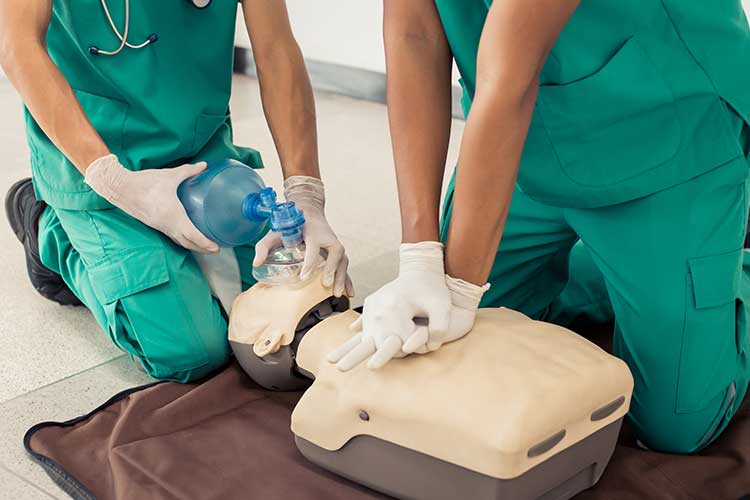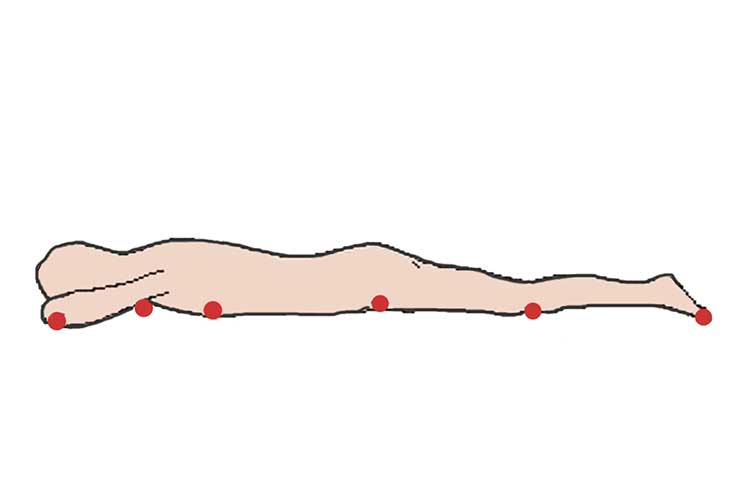Patients experiencing respiratory distress may be manoeuvered into the prone position for the delivery of ventilation if other methods have proven unsuccessful (Malhotra 2025). The prone position may also be used for patients undergoing spinal surgery or neurosurgery (UHS 2022).
These patients may begin to deteriorate or experience cardiac arrest, requiring immediate cardiopulmonary resuscitation (CPR) (Titilope & Bhardwaj 2023). In some circumstances, though it is not ideal, CPR may need to be performed while the patient is still in a prone position.

When is Prone CPR Performed?
Prone CPR is uncommon and unusual, as it is not a preferred position for resuscitation. A face-down patient impedes access to the airway and veins, posing a significant challenge to those performing the resuscitation (Bhatnagar et al. 2018; Nanjangud & Nileshwar 2017).
However, even though the supine position is considered optimal for CPR, and supine CPR is easier, it is not always feasible to manoeuvre a patient from prone to supine before commencing resuscitation (Titilope & Bhardwaj 2023). This is because:
- The process of turning a critically ill patient supine delays the commencement of compressions and means losing precious time
- Recruiting the necessary number of staff needed to perform a safe manoeuver (approximately four to six) may also delay the commencement of compressions
- Attempting to turn a critically ill patient may result in loss of airway or disconnection of invasive lines
- Manoeuvring a patient during spinal surgery or neurosurgery may cause neural damage
- The manoeuvre may cause injury to the patient or staff in an emergency situation.
(Nanjangud & Nileshwar 2017; ICS 2019; Saracoglu & Saracoglu 2018)
The American Heart Association (2020) states that:
‘The efficacy of CPR in the prone position is not established, but the very limited evidence suggests it may be better than providing no CPR, when a patient cannot be placed in supine position, or until this can be done safely.’
CPR may need to be performed on a patient in the prone position in some circumstances, or at least until they can be manoeuvered into the supine position (Nanjangud & Nileshwar 2017).

Is Prone CPR Successful?
Despite the infrequency of prone CPR, case reports detail a handful of successful resuscitations (Bhatnagar et al. 2018).
In all of these cases, the patient was mechanically ventilated and invasively monitored, with an advanced airway already secured prior to deterioration. Successful cases demonstrated compressions performed on the thoracic spine with the same rate and force as compressions that would be delivered in the supine position (Bhatnagar et al. 2018).
It has been concluded that if resuscitation is commenced immediately and the cause of arrest is simultaneously addressed, CPR in the prone position can generate a sufficient cardiac output (Case et al. 2025).
How to Perform Prone CPR
In order to perform any CPR, you must have basic or advanced life support training and knowledge on how to manage a deteriorating patient.
- Ensure the patient is safely positioned on the bed and all therapies are optimised as per the medical team.
- Refer to your local advanced and basic life support protocols.
- Ensure CPR mode on the bed is activated.
- Ensure the endotracheal tube is secure.
- Compressions should be delivered on the thoracic spine at the same rate and force as in the supine position.
- Both hands should be interlocked and placed on the patient’s back on the midthoracic spine T7-T9/10.
- Provide sternal counter pressure such as sandbags or 1-litre fluid bags under the patient’s chest.
- Chest compressions should be carried out at a rate of 100-120 compressions per minute.
- Ensure rotation amongst peers when performing CPR, as it is physically demanding.
(Al Harbi 2020; ICS 2019; Saracoglu & Saracoglu 2018; Bhatnagar et al. 2018; Feix & Sturgess 2014; Case et al. 2025)
Possible Complications
Complications from poor positioning may lead to an increase in mortality or morbidity rates. Other complications may include:
- Pressure injuries to the eyeballs, ribs, clavicles, scapula, shoulder joints or spine
- Accidental displacement of endotracheal or tracheostomy tubes
- Invasive line occlusion.
(Titilope & Bhardwaj 2023)

Conclusion
Despite being a relatively uncommon procedure, prone CPR has been proven successful if the situation is attended to immediately.
If a patient goes into cardiac arrest while in a prone position, and a manoeuvre is not feasible, it is best to begin CPR immediately and reposition the patient later if required. Ensure you apply sternal counterpressure to the patient.
Note: This article is intended as supplementary learning and should not replace best-practice care. Always ensure your advanced and basic life support training is up-to-date and that you refer to your organisation’s policy on performing CPR.
Test Your Knowledge
Question 1 of 3
True or false: The prone position is preferable for performing CPR.
Topics
Further your knowledge
References
- Al Harbi, MK, Alattas, KA, Alnajar, M & Albuthi, M F 2020, ‘Prone Cardiopulmonary Resuscitation in Elderly Undergoing Posterior Spinal Fusion with Laminectomy’, Saudi J Anaesthn., vol. 14 no. 1, viewed 29 April 2025, https://www.ncbi.nlm.nih.gov/pmc/articles/PMC6970382/
- Bhatnagar, V, Jinjil, K, Dwivedi, D, Verma, R & Tandon, U 2018, ‘Cardiopulmonary Resuscitation: Unusual Techniques for Unusual Situations’, J Emerg Trauma Shock., vol. 11 no. 1, viewed 29 April 2025, https://www.ncbi.nlm.nih.gov/pmc/articles/PMC5852913/
- Case, E, Luca, CE, Maino, P et al. 2025, ‘Prone Position and Cardiopulmonary Resuscitation in the Operating Room: A Scoping Review’, J Clin Med., vol. 14, no. 6, viewed 29 April 2025, https://www.mdpi.com/2077-0383/14/6/2044
- Feix, B & Sturgess J 2014, ‘Anaesthesia in the Prone Position’, Continuing Education in Anaesthesia Critical Care & Pain, vol. 14 no. 6, viewed 29 April 2025, https://academic.oup.com/bjaed/article/14/6/291/247907
- Intensive Care Society 2019, Guidance For: Prone Positioning in Adult Critical Care, Intensive Care Society, viewed 29 April 2025, https://ics.ac.uk/resource/prone-position-in-adult-critical-care.html
- Malhotra, A 2025, Acute Respiratory Distress Syndrome: Prone Ventilation in Adults, UpToDate, viewed 29 April 2025, https://www.uptodate.com/contents/acute-respiratory-distress-syndrome-prone-ventilation-in-adults
- Nanjangud, P & Nileshwar, A 2017, ‘Cardiopulmonary Resuscitation in Adult Patients in Prone Position’, vol. 6, no. 2, Indian Journal of Respiratory Care, viewed 29 April 2025, https://go.gale.com/ps/i.do?id=GALE%7CA565960523&sid=googleScholar&v=2.1&it=r&linkaccess=abs&issn=22779019&p=HRCA&sw=w&userGroupName=anon%7E4e6ed964
- Panchal, AR, Bartos, JA, Cabañas, JG et al. 2020, ‘Part 3: Adult Basic and Advanced Life Support: 2020 American Heart Association Guidelines for Cardiopulmonary Resuscitation and Emergency Cardiovascular Care’, Circulation, vol. 142, no. 16, viewed 29 April 2025, https://www.ahajournals.org/doi/10.1161/CIR.0000000000000916
- Saracoglu, A & Saracoglu, KT 2018, Cardiopulmonary Resuscitation in Prone Position During Surgical Interventions, American University of Beirut, viewed 29 April 2025, https://www.aub.edu.lb/fm/Anesthesiology/meja/Documents/Cardiopulmonary%20Resuscitation%20In%20Prone%20Position%20During%20Surgical%20Interventions.pdf#search=cpr
- Titilope, O & Bhardwaj, A 2023, ‘Prone Cardiopulmonary Resuscitation’, StatPearls, viewed 29 April 2025, https://www.ncbi.nlm.nih.gov/books/NBK587352/
- University Hospital Southampton 2022, Having a Neurosurgical or Spinal Operation in the Prone Position, NHS Foundation Trust, vivewed 29 April 2025, https://www.uhs.nhs.uk/Media/UHS-website-2019/Patientinformation/Surgery/Having-a-neurosurgical-or-spinal-operation-in-the-prone-position-3039-PIL.pdf
 New
New 

